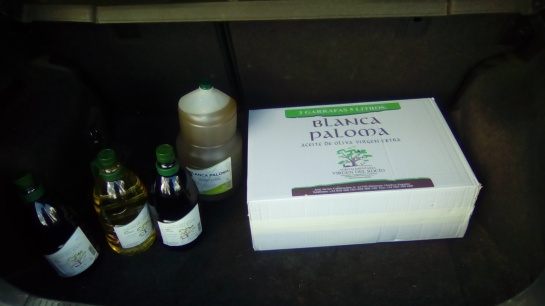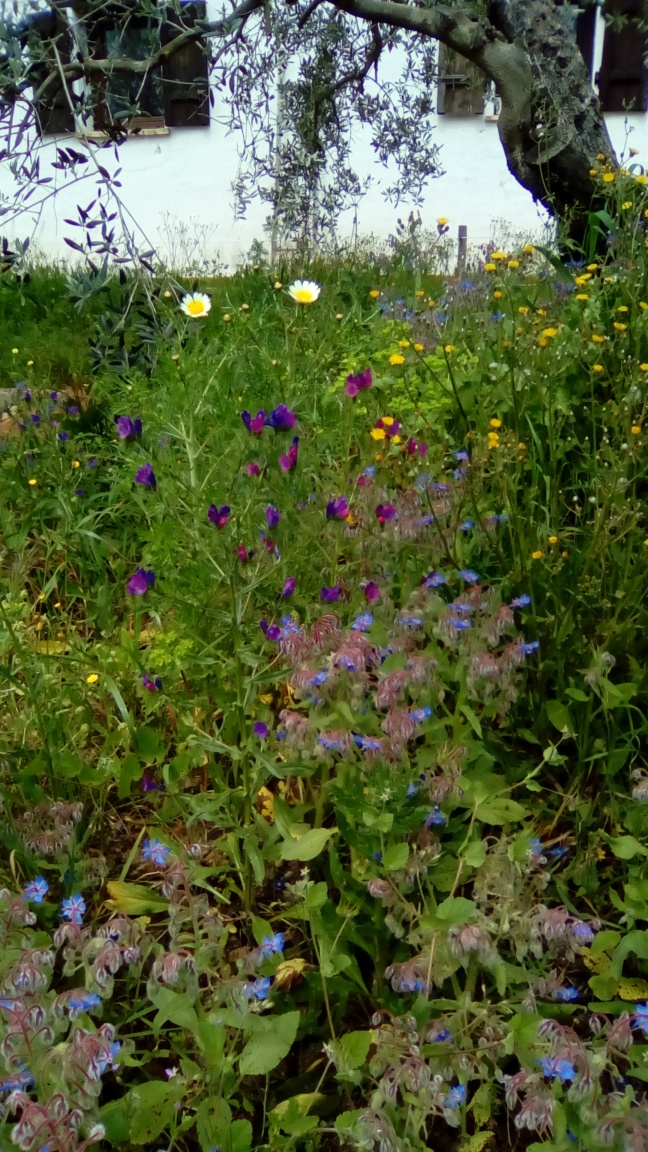
The lovely green carpet under the olives. Can anybody tell me what this pretty flower is? It belongs to the clover-like leaves, but is not a clover.
Our olive harvest is now finished, the pressure is off. It is hard to believe that we only started at the end of September for the first time ever to get close up and personal with this ancient, celebrated fruit. For over 4,000 years olives have been cultivated and used for nearly every aspect of life: as medicine, cosmetic ingredient, lamp oil, preservative, massage oil, lubricant for tools, furniture polish, leather treatment, paint remover, culinary additive and many more uses.
And we have had a steep learning curve in the past 3 months and developed a very intimate relationship with ‘our’ olive trees. Because they have been neglected for a number of years they have grown suckers and innumerable side shoots to the detriment of producing fruit.
Collecting the olives has been hard, but rewarding work and we hope it will be that much easier in the coming season. Payment however will only come when the olive oil has been sold through the Co-op, so we have to wait.

‘Blanca Paloma’ is the unfiltered virgin olive oil produced in our Co-op in Almonte. But they also produce wines from the local grapes. Reds, whites and sherry. So no need to ever run out of a good drop….
We now have to go back to every single tree and do some more pruning and ‘cleaning’, so that the trees will maximise fruit production and we get a better return on our work. We will also have time to learn and figure what is the best way to water the trees, when and how much.
We also took time to design and lay out the back garden. It is now populated with some flowering plants and some vegetables and herbs, the start of a wonderful friendship. I am so happy to invite these lovely beings into my life again. I did miss having a garden for the past year. Here, with the daily sunshine, it is even possible to sit and enjoy it in January.
Forgive me if I sound dramatic, but in my mind I have the past few years as dreary and rainy in memory. No sooner did I venture out in my cottage in Ireland I had to abandon my gardening ambitions and retreat inside again for the rain. The summers did seem to get ever wetter and duller and the winters marginally drier but still cold and dark, as winters are due to shorter daylight hours. Here in Andalucia we have sunshine every day and it does not feel like winter at all but rather like springtime, as the ground under the olives is a green carpet with dainty yellow flowers. The birds are chirping and everything is ready to spring to life again.
At Schipol Airport, Amsterdam, where we had a stop-over for 4 1/2 hours. We discovered the delight of the ‘Park’, complete with bird song and plants.
After a few days in Berlin to see my mum we are back in the finca.
Our neighbour expressed his horror about what we have been doing to the olive trees by making a cut-throat gesture with his hand. Even though looking around the other olive groves our trees look similar bereft of foliage. This discouraged Nigel to continue the work with the chain saw. But scrub at the base of the olive trees has to be cut. We will take a break until we get the promised expert to show us exactly how to prune overgrown trees and which of the branches to cut out.
We have now the start of a citrus fruit grove, with one mandarin tree and three orange trees fruiting at different times, together with the already in place lemon tree.
Our next project is a bamboo fence. Because it cost us nothing as the stuff (not sure what it is but it looks like bamboo) grows along the drain at the entrance. And also building a stone wall was not feasible as no natural stone can be sourced around here. We would have to haul stones from some distant quarry in the mountains. And so daily we gather, cut and stick bamboo sticks into the bricks that Nigel laid out. These will then be tied together with fine wire, my job.
We also did some experimenting with our olives. The first batch has now been in brine for 2 months and is ready for consumption. A jar full is now marinating in a Mediterranean Olive Oil Marinade for a different flavour and a second batch is now steeping in the brine. These olives are more of the riper stage, more black than green, as they were left-overs from our harvest. First tasting proves them to be rather of a strong flavour. Suited to inclusion in stews I think. We should try this again when they are still green when they are harvested for eating.
Nigel took a small quantity of black olives from the last tree and proceeded to squash them in a container and pound them to re-enact the very first humans making olive oil. I laughed seeing his efforts, but no more. To my utter astonishment these approximately 5 kgs of olives have already yielded a 450 ml jar of pure oil!
And that without any sophisticated equipment. The average yield is supposed to be 5 kgs of olives to one litre of olive oil [see http://alloliveoil.com/production.html ], which can vary due to variety, season, time of harvesting and numerous other influencing factors. We already brought home 20 l of unfiltered virgin olive oil from our co-op. And it looks more or less like the stuff Nigel patiently drained from his container. This makes us hopeful, although our area is dedicated to eating olives, which need more management but will give a better financial return. But when we watch our neighbouring olive farmers rattle their tractors through their olive groves to spray, plough, harrow and fertilise, we wonder about the actual return or profit of the crop. Cris’s father admitted that his 10 hectares of olives only give him ca. €5,000 after he has paid staff, machinery and input costs, which makes me question if it’s worth the effort. But at least he provides employment and can be proud of his excellent olives.

Storks nesting in Almonte.















































![9aa3d6f596b9999d61f91dd3d909e9d8[1] 9aa3d6f596b9999d61f91dd3d909e9d8[1]](https://fromirelandtospain.files.wordpress.com/2018/03/9aa3d6f596b9999d61f91dd3d909e9d81.jpg?w=299&resize=299%2C192&h=192#038;h=192)






























































































